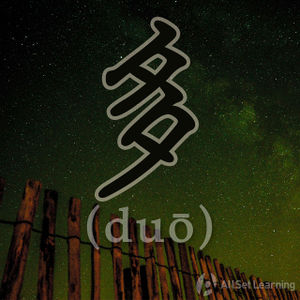Difference between revisions of "Intensifying with "duo""
| Line 42: | Line 42: | ||
* [[Boya Chinese Elementary Starter 1 (博雅汉语初经起步篇)]] (p. 211) [http://www.amazon.com/gp/product/7301075294/ref%3das_li_ss_tl?ie=UTF8&tag=allset-20&linkCode=as2&camp=217145&creative=399373&creativeASIN=7301075294 →buy] | * [[Boya Chinese Elementary Starter 1 (博雅汉语初经起步篇)]] (p. 211) [http://www.amazon.com/gp/product/7301075294/ref%3das_li_ss_tl?ie=UTF8&tag=allset-20&linkCode=as2&camp=217145&creative=399373&creativeASIN=7301075294 →buy] | ||
| − | *[[发展汉语 中级汉语口语上]] (p. 72) | + | * [[发展汉语 中级汉语口语上]] (p. 72) |
| − | + | * [[Chinese: An Essential Grammar, Second Edition]] (pp. 199) [http://www.amazon.com/gp/product/0415372615/ref=as_li_ss_tl?ie=UTF8&tag=allset-20&linkCode=as2&camp=217145&creative=399369&creativeASIN=0415372615 →buy] | |
[[Category:A2 grammar points]] | [[Category:A2 grammar points]] | ||
Revision as of 07:25, 14 May 2014
-
Level
-
Similar to
-
Used for
-
Keywords
One of the ways to make an exclamation and intensify something is to use 多(duō). It's really exciting!
Structure
As well as asking about degree, you can also use 多 (duō) to intensify adjectives.
Subject + 多 + Adjective !
Examples
- 外面 多 舒服!It's so nice outside!
- 多 好!That's great!
- 这 种 啤酒 多 好喝!This kind of beer tastes great!
- 你 看 这 个 地方,多 美!Look at this place, it is so beautiful!
- 学 中文 多 有 意思!Studying Chinese is so interesting!
- 你 穿 这么 少,多 冷 啊!You are wearing so few clothes, you must be so cold!
- 他们 每天 工作 十 二 个 小时,多 累!They work twelve hours every day, they must be so tired!
- 这样 做 多 不 方便!This is so inconvenient!
- 这 个 游戏 多 好玩!This game is so much fun!
- 这 个 房子 离 地铁 站 很 近,多 方便!This apartment is very close to the metro, it's so convenient!
- 多 好吃!It is so delicious!
- 汉字 多 难!我 不 学。Chinese characters are so difficult! I don't study them.
多 can be compared to 很 in this case. As you can see, if you put 很 in instead of 多, the meaning is basically the same. The exact meaning of 很 is "very"and the exact meaning of 多 is "a lot", therefore these two words can easily be interchanged as desired without changing the meaning.
See also
Sources and further reading
- Boya Chinese Elementary Starter 1 (博雅汉语初经起步篇) (p. 211) →buy
- 发展汉语 中级汉语口语上 (p. 72)
- Chinese: An Essential Grammar, Second Edition (pp. 199) →buy



